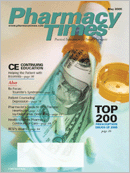Publication
Article
Pharmacy Times
Compliance Is Declining—How Can We Help?
Patient compliance continues tobe a major problem—one withdisturbing implications. Studiesconfirm that large numbers of patientsdo not stay on their medications and thatcompliance declines over time.
It is no surprise that every sector of thehealth care industry is trying to find solutions.One such sector is the pharmaceuticalindustry, whose compliance programscan be controversial even whenthey have positive results. PharmacyTimes has explored some recent complianceinitiatives and the controversy surroundingthem in ePharmacy Times, ouron-line newsletter, which can be found atour Web site, www.pharmacytimes.com.
As pharmacists, we should be in a goodposition to help with patient compliance.The regular contact between pharmacistand patient could present an ideal opportunityto discuss how a patient is doingwith his or her medication.
A pharmacist's time is not inexpensive,however, and it is worth noting that manycurrent industry efforts to manage compliancerely on comparatively low-costmethods, such as call centers. With staffshortages and shrinking reimbursements,there are plenty of more urgent mattersvying for a pharmacist's attention.
Yet, pharmacist involvement can makea difference. That difference has beendemonstrated by the health care projectin Asheville,NC—an example of collaborationbetween employers, health careproviders, pharmacists, and others, facilitatedby financial incentives offered topatients. Pharmacists received specialtraining and played a key role in helpingpatients manage diabetes more effectively.The result has been sustained improvementsin compliance and patienthealth, and there also have been financialbenefits.
From my perspective, it has been frustratingthat the Asheville model has notbeen more widely emulated. Perhaps thatsituation is changing, with the establishmentof similar recent initiatives, such asthe American Pharmacists AssociationFoundation's GlaxoSmithKline-supportedDiabetes Ten City Challenge.
Support from other health care playerscertainly makes it easier for pharmaciststo play a role in patient compliance. It alsocould help, however, if pharmacists weremore prepared to seize the initiative. Itmay be impossible to manage the complianceof every patient, but perhaps evenbusy pharmacists could find time to discusscompliance with just 5 patients.Doing so would be a start—one that indicatespharmacists' willingness to play aneven larger role.
Mr. Eckel is professor and director ofthe Office of Practice Developmentand Education at the School ofPharmacy, University of NorthCarolina at Chapel Hill.







